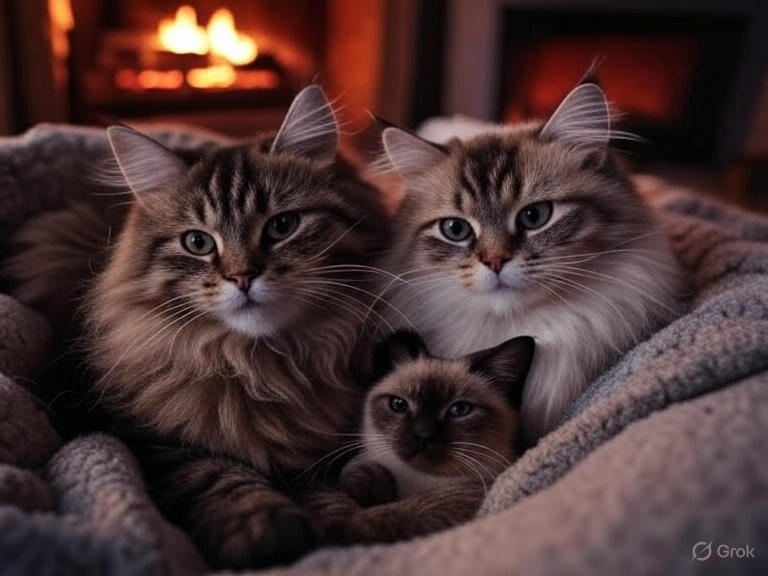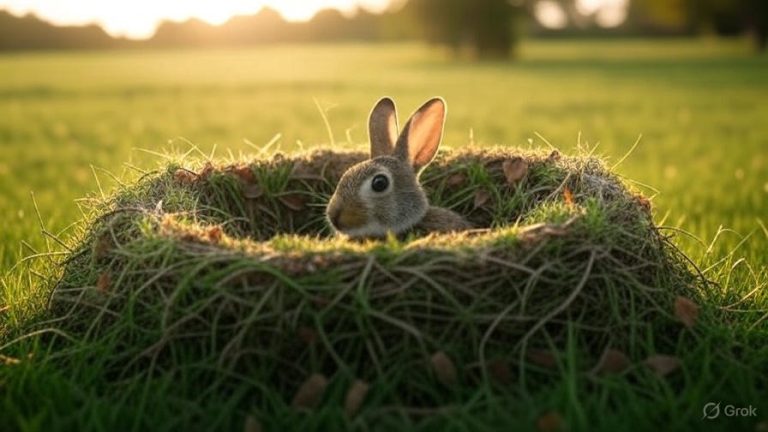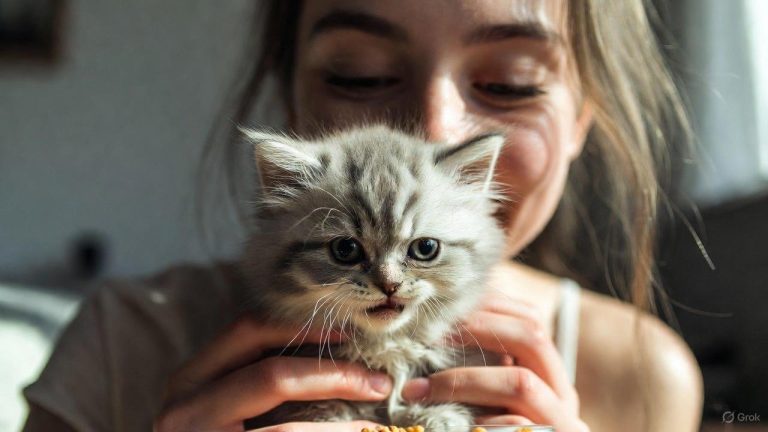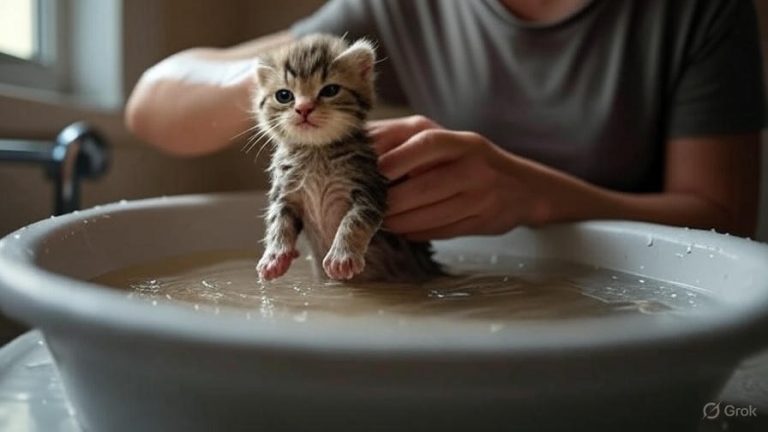How Cats Stay Warm During Winter?
Winter brings chilly temperatures that make us humans reach for our warmest coats and crank up the thermostat. But have you ever wondered how your feline friend manages to stay cozy during those freezing months? Cats possess remarkable natural abilities that help them maintain their body temperature even when the mercury drops. Their survival mechanisms have evolved over thousands of years, creating an impressive biological heating system that keeps them comfortable in cold weather.
The secrets behind feline winter warmth involve a combination of physical adaptations, behavioral changes, and instinctive strategies. From their dense fur coats to their clever heat-seeking behaviors, cats have developed multiple ways to conserve body heat and stay warm throughout the coldest seasons.
The Science Behind Feline Body Temperature Regulation
Cats maintain a higher body temperature than humans, typically ranging between 100.5°F and 102.5°F. This elevated baseline temperature gives them a head start when dealing with cold environments. Their metabolic rate increases during winter months, burning more calories to generate internal heat through a process called thermogenesis.
The feline circulatory system plays a crucial role in temperature regulation. When exposed to cold, cats can constrict blood vessels near their skin surface, redirecting warm blood to vital organs. This automatic response, known as vasoconstriction, helps preserve core body temperature while sacrificing heat in extremities like ears, paws, and tail tips.
Cats also possess brown adipose tissue, commonly called brown fat, which burns calories specifically to produce heat. This specialized fat tissue contains numerous mitochondria that convert stored energy directly into warmth. Unlike regular fat that stores energy, brown fat actively generates heat when the body needs it most.
Natural Fur Coat: The Ultimate Winter Insulation
A cat’s fur coat serves as their primary defense against winter cold. Most cats develop a thicker, denser coat as autumn approaches, preparing for the temperature drop ahead. This process, called seasonal coat changes, involves growing additional undercoat hairs that trap warm air close to the skin.
The typical feline coat consists of three distinct layers. Guard hairs form the outer protective layer, repelling moisture and providing the first barrier against cold air. Awn hairs make up the middle layer, offering insulation while maintaining the coat’s shape. The undercoat contains the finest, softest hairs that trap air and create the most effective insulation.
Long-haired breeds like Maine Coons and Persian cats have naturally superior winter protection due to their abundant fur. However, even short-haired cats develop seasonal adaptations that increase their coat density. The space between individual hairs fills with warm air, creating natural insulation similar to down filling in winter jackets.
Cats spend considerable time grooming their coats, and this behavior becomes even more important during winter. Proper grooming helps fluff the fur, maximizing its insulating properties. The natural oils distributed during grooming also help repel moisture and maintain the coat’s protective qualities.
Behavioral Adaptations for Cold Weather Survival
Cats demonstrate remarkable behavioral changes when temperatures drop. These instinctive actions help them conserve energy and maintain warmth through challenging winter conditions. Observing these behaviors can help cat owners better support their pets during cold seasons.
Sleep patterns change significantly during winter months. Cats naturally sleep more, sometimes up to 20 hours per day when it’s particularly cold. This extended rest period conserves energy that would otherwise be used to maintain body temperature. By reducing activity levels, cats preserve precious calories for heat production.
The famous cat loaf position becomes even more common in winter. This compact posture tucks paws underneath the body and wraps the tail around, minimizing exposed surface area. Heat loss occurs primarily through extremities, so protecting these areas helps maintain overall body temperature.
Cats also seek out warm surfaces with increased determination during cold weather. They gravitate toward sunny windowsills, heating vents, warm appliances, and cozy blankets. This heat-seeking behavior helps supplement their natural warming mechanisms by absorbing external heat sources.
Social behaviors can change too, with some cats becoming more affectionate and seeking body warmth from their human companions. Even typically independent cats might cuddle more frequently during winter, sharing body heat as a survival strategy.
Strategic Heat-Seeking Behaviors
Indoor cats become expert heat detectors during winter months. They can sense warm spots throughout the house that humans might not even notice. Refrigerator tops, computer monitors, and recently used dryers all provide attractive warming opportunities.
Sunbathing takes on new importance during winter. Cats will follow sun patches across the room throughout the day, maximizing their exposure to natural warmth. Even weak winter sunlight can provide significant heat benefits, especially when absorbed by dark-colored fur.
Many cats discover the warmth generated by heating systems and position themselves strategically near vents, radiators, or baseboard heaters. They learn household heating schedules and appear in these prime locations just as the heat kicks on.
Electronic devices also attract winter-seeking cats. Televisions, gaming consoles, and computers generate heat that cats readily exploit. This behavior explains why so many cats seem drawn to keyboards and warm laptops during cold weather.
Caloric Needs and Winter Metabolism
Cold weather increases a cat’s caloric requirements as their body works harder to maintain proper temperature. Outdoor cats may need 25-50% more food during winter months compared to warmer seasons. Even indoor cats experience some metabolic changes that affect their appetite and energy needs.
The digestive process itself generates heat through metabolic activity. Cats may eat smaller, more frequent meals during winter, which helps maintain steady heat production throughout the day. This eating pattern also prevents the energy dip that can occur after large meals.
Protein becomes especially important during cold weather because it requires more energy to digest than carbohydrates or fats. This increased metabolic work generates additional body heat as a beneficial side effect of nutrition processing.
Fat reserves built up during autumn months serve as both insulation and emergency fuel for heat production. Cats instinctively prepare for winter by eating more during late summer and fall, building up these protective fat stores.
Shelter-Seeking Instincts
Wild and outdoor cats demonstrate sophisticated shelter-seeking behaviors that help them survive harsh winter conditions. These instincts remain strong even in pampered house cats, who still seek out enclosed, protected spaces during cold weather.
Small, enclosed spaces appeal to cats because they’re easier to warm with body heat. Cardboard boxes, pet caves, and tight hiding spots all provide natural warming chambers. The confined space traps warm air and reduces the volume of air that needs heating.
Cats prefer shelters with single entrances that can be easily monitored and defended. This preference stems from survival instincts but also serves thermal purposes by limiting cold air circulation within the shelter.
Elevated sleeping spots offer protection from cold air that settles near floor level. Cats instinctively seek higher perches during cold weather, taking advantage of the fact that warm air rises.
Indoor vs Outdoor Winter Challenges
Indoor cats face different winter challenges compared to their outdoor counterparts. While they don’t deal with freezing temperatures, indoor cats must adapt to artificial heating systems and potentially dry air conditions.
Central heating can create uneven temperatures throughout a house, leading cats to migrate between rooms seeking optimal comfort zones. They quickly learn which areas stay warmest and adjust their daily routines accordingly.
Dry winter air from heating systems can affect cat comfort and health. Some cats may seek out humid areas like bathrooms or laundry rooms where moisture levels remain higher.
Outdoor cats face much more severe challenges, including finding adequate shelter, accessing unfrozen water, and obtaining enough food to fuel their increased metabolic needs. Their winter survival depends heavily on finding protected areas that block wind and precipitation.
Health Considerations During Cold Weather
Winter weather can impact feline health in various ways. Older cats and those with certain medical conditions may struggle more with temperature regulation. Arthritis symptoms often worsen in cold weather, making cats less active and potentially affecting their ability to generate body heat through movement.
Cats with thin coats or sparse fur, including certain breeds and senior cats, may need additional support during winter months. These cats might benefit from heated beds, extra blankets, or even specialized cat clothing for outdoor adventures.
Dehydration becomes a concern during winter because cats may drink less water if it’s too cold. Ensuring access to fresh, room-temperature water helps maintain proper hydration, which supports healthy circulation and temperature regulation.
Paw pad care becomes important for cats that venture outdoors during winter. Ice, snow, and salt can damage sensitive paw pads, potentially affecting a cat’s ability to walk normally and seek warm shelter.
Supporting Your Cat’s Natural Warming Abilities
Cat owners can help support their pets’ natural winter warming strategies without interfering with healthy instincts. Providing multiple warm resting spots gives cats options for finding their preferred comfort level throughout the day.
Heated pet beds offer consistent warmth that doesn’t depend on sunny weather or heating schedules. These beds allow cats to conserve energy by not having to work as hard to maintain body temperature.
Maintaining consistent indoor temperatures helps prevent stress on feline temperature regulation systems. Sudden temperature changes can shock a cat’s system and make it harder for them to adjust naturally.
Draft elimination makes a significant difference in feline comfort. Sealing gaps around windows and doors helps maintain stable indoor temperatures and prevents cold air from disrupting warm sleeping spots.
The Role of Age in Winter Temperature Regulation
Kittens and senior cats face special challenges during winter months. Very young cats haven’t fully developed their temperature regulation systems, while older cats may have declining efficiency in their natural warming mechanisms.
Kittens rely heavily on external heat sources and may struggle to maintain proper body temperature independently. They benefit from extra warm bedding and protection from drafts.
Senior cats often have reduced muscle mass, which affects their ability to generate heat through normal activity. They may also have circulation issues that impact their natural temperature control systems.
Middle-aged healthy cats typically handle winter conditions best, with fully developed warming systems and good muscle mass for heat generation.
Environmental Factors That Affect Feline Warmth
Humidity levels play a role in how cold cats feel during winter. Low humidity makes the air feel colder and can affect how efficiently cats maintain their body temperature. Slightly higher humidity levels can improve comfort without creating moisture problems.
Air circulation patterns within homes influence where cats choose to rest. Areas with good air flow may feel colder even at the same temperature, leading cats to avoid these spots during winter.
Floor types affect heat retention and comfort. Cats often avoid cold surfaces like tile or hardwood floors during winter, preferring carpeted areas or rugs that provide insulation from cold surfaces.
Natural vs Artificial Warming Solutions
While cats possess excellent natural warming abilities, artificial heat sources can provide valuable supplemental comfort. The key lies in offering options rather than forcing solutions that might interfere with natural behaviors.
Heated cat beds work well because they mimic the warmth cats would naturally seek from sunny spots or warm surfaces. These beds allow cats to choose when they want extra warmth without overriding their natural temperature preferences.
Heat lamps designed for pets can create warm zones that cats can move in and out of as needed. This setup respects feline independence while providing reliable warmth during the coldest periods.
Avoiding overheating becomes important when using artificial warming devices. Cats need the ability to move away from heat sources when they become too warm, maintaining their natural temperature balance.
Winter survival for cats represents a fascinating blend of biological adaptation and behavioral intelligence. Their multi-layered approach to staying warm demonstrates millions of years of evolutionary refinement. From their remarkable fur coats to their heat-seeking behaviors, cats have developed comprehensive strategies for maintaining comfort during cold weather.
The key to supporting cats during winter involves respecting their natural abilities while providing thoughtful assistance when needed. By recognizing how cats naturally stay warm, we can better appreciate these remarkable creatures and ensure they remain comfortable throughout the coldest months of the year.
Pet owners who observe their cats’ winter behaviors will notice the sophisticated ways these animals adapt to seasonal changes. Each cat may have slightly different preferences and strategies, but all share the fundamental biological tools that have helped felines thrive in various climates around the world.
The next time you see your cat curled up in a sunny spot or seeking out that warm corner near the heater, you’ll know you’re witnessing thousands of years of evolutionary wisdom in action. These behaviors aren’t just cute quirks – they’re essential survival strategies that showcase the remarkable adaptability of our feline companions.







